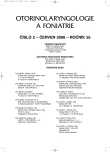Uzlinové krční metastázy spinocelulárního karcinomu orofaryngu a hrtanu (1. část)
Nodular Cervical Metastases of Spinocellular Carcinoma of Oropharynx and Pharynx (Part 1)
Summary:
The authors present a prospective study aimed at the evaluation of palpation, ultrasonography (USG), computing tomography (CT) and nuclear magnetic resonance (MRI) in the diagnostics of cervical metastases of spinocellular carcinoma (SCC) of oropharynx and pharynx. The study included 49 patients with SCC of oropharynx or pharynx over the period of 2.5 years with the following criteria for cervical metastases: 1. Maximum transverse dimension of lymphatic node > 15 mm in the sector I and > 10 mm in other sectors. 2. L/T quotient < 2 (ratio between the maximum longitudinal and maximal or minimal transverse diameter of the lymphatic node). 3. A group of three or more mutually unbounded lymphatic nodes of the size between 8 and 10 mm. 4. Central necrosis. 5. Extranodal dissemination. The sensitivity of palpation proved to be 53% and the specificity 67%. USG reached sensitivity and specificity 74% alike according to the criterion of size, sensitivity of 79% and specificity of 93% was reached according to L/T quotient and sensitivity of 90% and specificity of 98% was reached according to central necrosis. A common combination of all USG criteria revealed sensitivity of 85% and specificity of 87%. In selecting the criterion of the size CT and MRI proved to reach sensitivity of 71% and 78%, respectively and specificity of 90% and 85%, respectively. The central necrosis displayed sensitivity of 88% and 89% and specificity of 99% and 96% for CR and MRI, respectively. In the combination of all criteria the authors reached sensitivity of 75% for CT and 78% for MRI and specificity of 87% for CT and 85% of MRI. The authors arrived at the conclusion that the diagnostics of nodular cervical metastases on the basis of palpation is insufficient. The results obtained by USG diagnostics are reliable. The diagnostic value of L/T quotient and central necrosis is high. The diagnostic possibilities of CT and MRI proved to be similar. A common combination of all criteria proved to be best for all techniques. The presumption of a rapid improvement in the detection of nodular cervical metastases on the basis of CT and MRI examinations has not been confirmed and USG proved to be even more useful in some parameters of evaluating nodular affection.
Key words:
cervical dissection, nodular cervical metastases, palpation, ultrasonography, computing tomography, nuclear magnetic resonance.
Autoři:
P. Praženica; J. Lacman 1; R. Holý; M. Navara; Z. Voldřich
Působiště autorů:
Otorinolaryngologické oddělení, Ústřední vojenská nemocnice Praha
přednosta plk. MUDr. M. Navara
Radiodiagnostické oddělení, Ústřední vojenská nemocnice Praha
; přednosta pplk. MUDr. F. Charvát
1
Vyšlo v časopise:
Otorinolaryngol Foniatr, 55, 2006, No. 2, pp. 103-107.
Kategorie:
Původní práce
Souhrn
Souhrn:
Autoři prezentují prospektívní práci, jejímž cílem je zhodnocení palpace, ultrasonografie (USG), počítačové tomografie (CT) a nukleární magnetické rezonance (MRI) v diagnostice uzlinových krčních metastáz spinocelulárního karcinomu (SCC) orofaryngu a hrtanu. Do studie bylo zařazeno 49 pacientů s SCC orofaryngu anebo hrtanu za období 2,5 roku s následujícími kritérií uzlinových krčních metastáz: 1. Maximální příčný rozměr lymfatické uzliny > 15 mm v sektoru I a > 10 mm v ostatních sektorech. 2. L/T kvocient < 2 (poměr mezi maximálním podélným a maximálním anebo minimálním příčným průměrem lymfatické uzliny). 3. Skupina třech a více, navzájem neohraničených lymfatických uzlin velikosti od 8 do 10 mm. 4. Centrální nekróza 5. Extranodální šíření. Senzitivita palpace byla 53% a specificita 67%. USG dle kritéria velikosti dosáhla senzitivitu a specificitu shodně 74%, podle kritérií L/T kvocientu senzitivity a specificity v 79 % a 93 % a podle centrální nekrózy senzitivity 90 % a specificity 98 %. Společnou kombinací všech USG kritérií autoři zjistili senzitivitu 85% a specificitu 87%. Při zvolení kritéria velikosti dosáhly CT a MRI senzitivity 71 %, resp. 78%, specificity 90 %, resp. 85 %. Centrální nekróza měla senzitivitu 88 % a 89 % pro CT, resp. MRI a specificitu 99 % a 96 % pro CT, resp. MRI. Kombinací všech kritérií autoři získali senzitivitu v 75 % pro CT a v 78 % pro MRI a specificitu v 87 % pro CT a 85 % pro MRI. Autoři konstatují, že diagnostika uzlinových krčních metastáz na podkladě palpace je nedostatečná. Výsledky získané USG diagnostikou jsou spolehlivé. Diagnostická hodnota L/T kvocientu a centrální nekrózy je vysoká. Diagnostické možnosti CT a MRI jsou podobné. Pro všechny techniky je optimální společná kombinace všech kritérií současně. Předpoklad rapidního zlepšení detekce uzlinových krčních metastáz na podkladě CT a MRI vyšetření se nepotvrdil, naopak v některých parametrech hodnocení uzlinového postižení se USG jeví dokonce užitečnější.
Klíčová slova:
krční disekce, uzlinové krční metastázy, palpace, ultrasonografie, počítačová tomografie, nukleární magnetická rezonance.
Štítky
Audiologie a foniatrie Dětská otorinolaryngologie OtorinolaryngologieČlánek vyšel v časopise
Otorinolaryngologie a foniatrie

2006 Číslo 2
Nejčtenější v tomto čísle
- Tonzilektómie za tepla a za studena
- Uzlinové krční metastázy spinocelulárního karcinomu orofaryngu a hrtanu (2. část)
- Slizniční melanomy hlavy a krku
- Chirurgická léčba cholesteatomu
